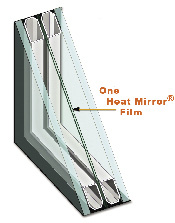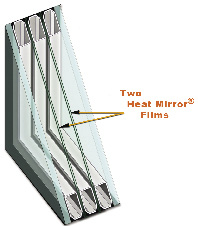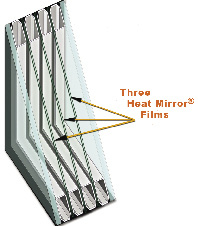The big secret regarding energy efficiency in commercial buildings is window glass, which compared to insulated walls and ceilings, is a terrible energy loser. While we expect that energy-conserving walls and ceilings will dramatically insulate against heat loss and block direct solar radiation knowledgeable building managers and project developers anticipate far less in the way of energy conservation from even the most energy efficient windows.
The numbers speak for themselves. Walls with an insulation performance value of R-19 are considered to be the norm. (R means resistance to heat flow. The higher the number the better the insulation performance, in winter keeping heat in, in summer keeping it out). On the other hand, windows with low emissivity (Low-e) coated glass touting the coveted Energy Star® designation, and whose insulation performance tops out at R-4, are celebrated by architects, contractors and building managers. These knowledgeable observers rightfully see such defacto energy-conserving windows as a substantial improvement over conventional insulating glass whose insulation performance cannot exceed R-2.
But why do we expect our buildings to contain R-19 insulated walls and at the same time are willing to accept R-4 windows? Such an energy conservation double standard exists because it is easier to be a wall than a window. Walls only have to insulate well.
Windows must be transparent and colorless, facilitating the transmission of natural daylight, while reflecting unwanted solar energy, decrease ultraviolet radiation that causes fading of building components and furnishings, reduce sound transmission and of course, insulate against heat loss in winter and heat gain in summer. Windows must open to provide ventilation and egress in emergency situations. Compared to walls, a window must simultaneously perform numerous functions many of which are highly sophisticated.
Despite heavily insulated walls and ceilings and the popularity of Energy Star designated windows, 25%-35% of the energy used in homes and buildings is wasted due to inefficient glass. So, it should come as no surprise that glass is responsible for >10% of the total carbon emissions in the US annually and is a major contributor to global warming. In addition, inefficient windows and glass cause unhappy and uncomfortable commercial tenants all too often too cold in winter and too hot in summer and paying more than they should in heating and cooling costs year-round.
One might think the easiest solution for building managers would be to board-up many existing windows. While such a drastic move might save some energy it would negate the increasingly recognized benefits of day lighting, the ability to transmit natural light into office and retail buildings through existing openings in walls and ceilings. The benefits of day lighting include:
*reduced use of artificial illumination
*reduced sickness and attrition of office workers
*reduced recovery times on the part of healthcare
facility patients
*increased sales in retail spaces
*improved tenant retention and acquisition
When ordering new windows, here's what property managers need to know about glass options.
* Single pane glass may keep out the weather but it does little to insulate against heat loss or reflect the sunʼs heat that can cause overheating.
* Insulating glass (two panes sealed together) with a solar heat-reflective coating is appropriate for buildings concerned with staying warm in winter, cool in summer. * Insulating glass with dual heat reflective coatings that simultaneously reflect heat from the sun and ambient heat both inside and outside is even more effective in saving energy and increasing occupant comfort.
Many might think this is where the story ends. However, recent and impending revisions to the Department of Energy's Energy Star window performance standards will require windows possessing the coveted Energy Star designation to provide increased energy efficiency.
Glass available today that will meet the new and forthcoming Energy Star window performance standards include:
*Triple pane glass consisting of three panes of glass and two heat reflective coatings. The good news is that by using a third pane of coated glass triple pane improves insulating glass performance. The bad news is that triple pane glass is 50% heavier than insulating glass, requiring stronger window framing and increasing cost accordingly.
*Heat reflective insulating glass containing a transparent heat reflective film inside the air space can increase insulation performance while reflecting unwanted solar heat. Single, double and even triple internal films that create as many as four separate cavities inside the insulating glass unit can achieve a center of glass insulation value of R-20 superior to an insulated wall.
Bruce Lang is vice president of marketing & business development, Southwall Technologies, Inc., Palo Alto, CA.
Tags:
Money out the window: Windows and walls,a double standard in energy efficiency
September 23, 2010 - Green Buildings










